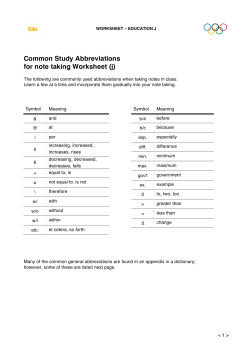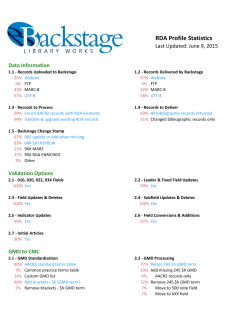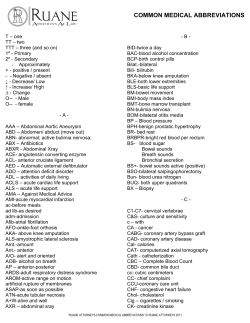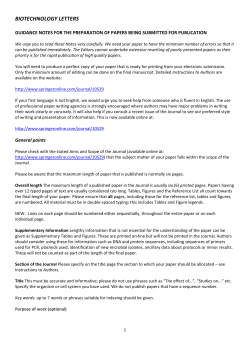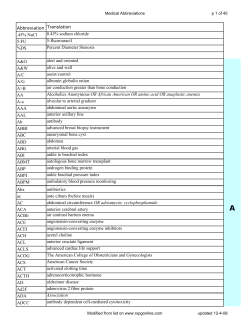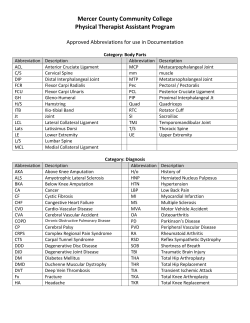
Accepted Abbreviations List PURPOSE
Accepted Abbreviations List PURPOSE The purpose of the abbreviation list is to define recommended abbreviations that may be used in the documentation of patient care within the CCEMS system. Abbreviations are often used to facilitate and shorten written narratives. This is an acceptable practice as long as it is universally recognized and understood abbreviations are used. The following are medical abbreviations that are acceptable for use by EMS personnel in the CCEMSA region. In situations where an abbreviation is not listed and the provider intends to use the abbreviation more than once in the patient care report (PCR) the provider may spell out the complete term to be abbreviated with the abbreviation immediately following the term enclosed in brackets (i.e., “()” ). A. Unlisted abbreviations that are acceptable to use are the following: 1) Hospitals, clinics or other medical facilities: When abbreviating facilities use the first letter of each word of the proper title and only abbreviate the facility if it is already written in entirety on the PCR as the response location or destination. 2) Fire: When abbreviating a fire department “FD” must follow any letters used to abbreviate the city or municipality fire department. 3) Police: When abbreviating a police department or Police Officer response “PD” must follow any letters used to abbreviate the city or municipality police department. 4) Sheriff: When abbreviating a sheriff department or Sheriff Officer “SO” must follow any letters used to abbreviate the city or municipality sheriff department. B. Abbreviations acceptable to use on PCRs in the CCEMSA systems are listed as follows (see table below). & ? ^ or ∆ + < = > ♀, F ♂, M 11-44 2nd, 3rd, etc. 5150 A/OX1,2,3,4 Abd Abr ACE AED A-fib A-flutter AICD Accepted Acceptable Abbreviations Negative, without, decrease And Possible, questionable Change Positive, with, increase Less than Equal Greater than Female Male Fatality or Deceased Used when describing order Danger to self, others, gravely disable with mental illness Alert, and (1) Oriented to Person, (2) Place, (3) Time, and (4) Event. Abdomen Abrasion Angiotension converting enzyme Automated External Defibrillator Atrial Fibrillation Atril Flutter Automatic Internal Cardiac Defibrillator AIDS ALOC ALS AM AMI AOS AMS A-P APAP APGAR ASA ASHD AU AV BG BID BLS BM BP BVM C/C C/o C1, C2 CA Ca++ CABG CAD CALF Cap CBC cc CCU chemo CHF CHP cm CNS CO CO2 COPD CP CPAP CPR CSF CSMT C-spine CT or CAT CVA D/C DNR DOB DOE DT Acquired immunodeficiency syndrome Altered level of consciousness Advanced life support Morning Acute myocardial infarction Arrived On Scene Altered mental status Anteroposterior (front to back) Acetaminophen Appearance, Pulse, Grimace, Activity, Respiration Acetylsalicylic acid Arteriosclerotic heart disease Both Ears Atrioventricular Blood glucose Twice a day Basic life support Bowel movement Blood pressure Bag-valve-mask Chief complaint Complains of First, Second, etc., cervical vertebra Cancer or Carcinoma Calcium Coronary artery bypass graft Coronary artery disease CalFire* Capsule Complete blood count Cubic centimeter Coronary care unit Chemotherapy Congestive heart failure California Highway Patrol* Centimeter Central nervous system Carbon monoxide Carbon dioxide Chronic obstructive pulmonary disease Chest Pain Continuous Positive Airway Pressure Cardiopulmonary resuscitation Cerebral spinal fluid Circulation, sensation, movement, temperature Cervical precautions applied Computed tomography (Scan) Cerebrovascular accident Discontinue Do not resuscitate Date of birth Dyspnea on exertion Delirium tremens DVT Dx ECG or EKG ED EDC EMS EMT EMT-P ENT ET or ETT ETCO2 ETOH FACTS Fe FHR FHx FR FTB Fx gm g GB GCS GERD GI GPA GSW gtt(s) GYN H2O HA HBV HCV HIV HPI HSV-1, HSV-2 HTN Hx I&O IC ICP ICU IDDM IM IO IV IVDU JVD K+ KED Kg L1, L2 LA Deep vein thrombosis Diagnosis Electrocardiogram Emergency Department Expected date of confinement Emergency Medical Services Emergency Medical Technician Emergency Medical Technician - Paramedic Ears, nose, throat Endotracheal tube End-Tidal Carbon Dioxide (level) Ethyl alcohol Mnemonic for: Focus, Activity, Color, Time (onset and duration), and Supplemental history. Iron Fetal heart rate Family history First responder or French sizing Full-Thickness Burn Fracture Gram Gauge Gallbladder Glasgow coma score Gastroesophageal reflux disease Gastrointestinal Gravida, Para, Abortus (i.e., G2, P1, A1) Gunshot wound Drop(s) Gynecology Water Headache Hepatitis B virus Hepatitis C virus Human immunodeficiency virus History of present illness Herpes simplex virus type 1 or 2. Hypertension History Intake & output Incident Commander Incident Command Post Intensive care unit Insulin-dependent diabetes mellitus Intramuscular Intraosseous Intravenous Intravenous drug use Juggler vein distention Potassium Kendrick Extrication Device Kilogram (1000 grams) First, second, etc., lumbar vertebra Left atrim Lat LBBB LLE LLQ LNMP LOC LP LR Lt LUE LUQ LV LVH LVN MAE MCC mcg MD MDMA Meds or Med meth mg MI ml mm MOI MRI MRSA MS MVC N/V/D NA Na+ NC NIDDM NKA NKDA NP or FNP NPA NPO NRB NRS NS NSAID NSR NTG O.D. O.S. O.U. O2 OA OD OOS Lateral Left bundle branch block Left lower extremity Left lower quadrant Last normal menstrual period Loss of consciousness Lumbar puncture Lactated ringers Left Left upper extremity Left upper quadrant Left ventricle Left ventricular hypertrophy Licensed vocational nurse Moves all extremities Motor cycle collision Micrograms Medical Doctor 3,4-Methylenedioxymethamphetamine commonly known as Ecstasy Medications Methamphetamine Milligram (1/1000 gram) Myocardial infarction Milliliter (1/1000 liter) Millimeter (1/1000 meter) Mechanism of injury Magnetic resonance imaging Methicillin-resistant Staphylococcus aureus Morphine sulfate Motor vehicle collision Nausea, vomiting, diarrhea Nerve Agent (Tabun, Sarin, Soman, GF, VX) Sodium Nasal cannula Non-insulin dependent diabetes No known allergies No known drug allergies Nurse practitioner / family nurse practitioner Nasal pharyngeal airway Nothing by mouth Non-rebreather Numeric Rating Scale (1-10) (1= Low, 10=High) Normal saline Non-steroidal anti-inflammatory drug Normal sinus rhythm Nitroglycerin Right eye Left eye Both eyes Oxygen Osteoarthritis Overdose Out of Service OPA OPQRST P PA PAC PASTE PASTMED PE PEA PERRL PFSH PID PM PMD PMH PN PND PNS POP PRN Pt PTA PTB PVC Q QH QID Resp. RR R/O RA RBBB RBC RLE RLQ RMCT RN ROM ROS RSV Rt RUE RUQ RV Rx S/S SA SAMPLE Oral pharyngeal airway Mnemonic for: Onset, Provoke, Quality, Radiates, Severity, and Time. Pulse Physician assistant Premature atrial contraction Mnemonic for: Progression, Associated chest pain, Sputum, Time, Exertion. Mnemonic for: Provocation, Associated chest pain, Sputum (color and amount), Time, Medications, Exertion, and Diagnosis. Physical examination or pulmonary embolism Pulseless electrical activity Pupils equal, round, and reactive to light Mnemonic for: Past, Family and Social History Pelvic inflammatory disease Afternoon Primary medical doctor Past medical history Pain Paroxysmal nocturnal dyspnea Peripheral nervous system Pain on palpation As needed Patient Prior to arrival Partial-Thickness Burn Premature ventricular contraction Every Each hour Four times a day Respirations Respiratory Rate Rule out Rheumatoid arthritis or Right Atrium Right bundle branch block Red blood cell Right lower extremity Right lower quadrant Refusal of medical care and/or transport Registered nurse Range of motion Review of symptoms Respiratory syncytial virus Right Right upper extremity Right upper quadrant Right ventricle Prescription Signs and symptoms Sinoatrial node Mnemonic for: Signs and symptoms, Allergies, Medications, Past history, Last oral intake, Events leading up to. Sc or Sq SL SLUDGEM SNF SOAP SOB SpO2 START Stat STB STD STEMI Strep Sx T or Temp. T1, T2 TA Tab TB TC TIA TID TKO Trans TTJI Tx Unk URI UTL V/S VF VT or V-Tach W/ or C_Bar W/O or S_Bar WBC WMD WNL X Y/O Subcutaneous Sublingual Mnemonic for: Salivation, Lacrimation, Urination, Defecation, Gastrointestinal distress, Emesis and Miosis. Skilled nursing facility Mnemonic for: Subjective, Objective, Assessment, and Plan. Shortness of breath Oxygen Saturation of peripheral Hgb Simple Triage and Rapid Treatment Immediately Superficial-Thickness Burn Sexually transmitted disease S-T elevation myocardial infarction Streptococci (bacteria) Symptoms Temperature First, second, etc., thoracic vertebra Traffic Accident Tablet Tuberculosis Traffic Collision Transient ischemic attack Three times a day To keep open Transport Transtracheal jet insufflation Treatment Unknown Upper respiratory infection Unable to locate Vital signs Ventricular fibrillation Ventricular tachycardia With, C_Bar is a “C” with a line over. Without, S_Bar is a “S” with a line over. White blood cell Weapon of mass destruction Within normal limits Times (used as multiplication sign) Year(s) old * The California Highway Patrol (CHP) and CalFire (CALF) have specific abbreviations because their response areas are in the entire CCEMSA region; hence they are not covered in section A of the listed abbreviations.
© Copyright 2025
